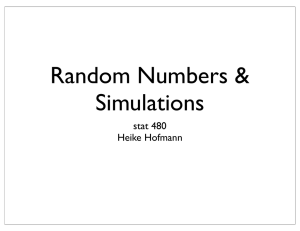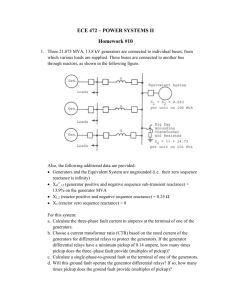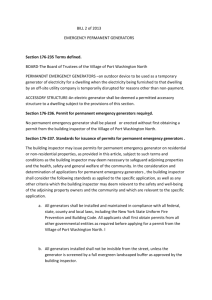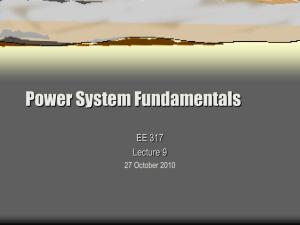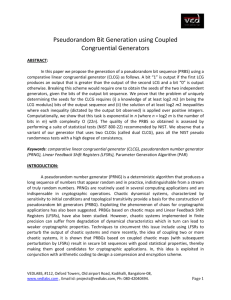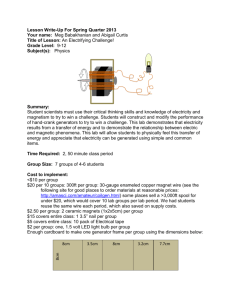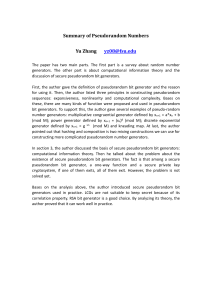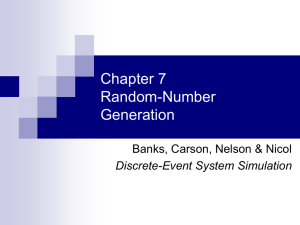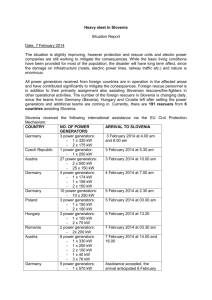Random Number Generation
advertisement
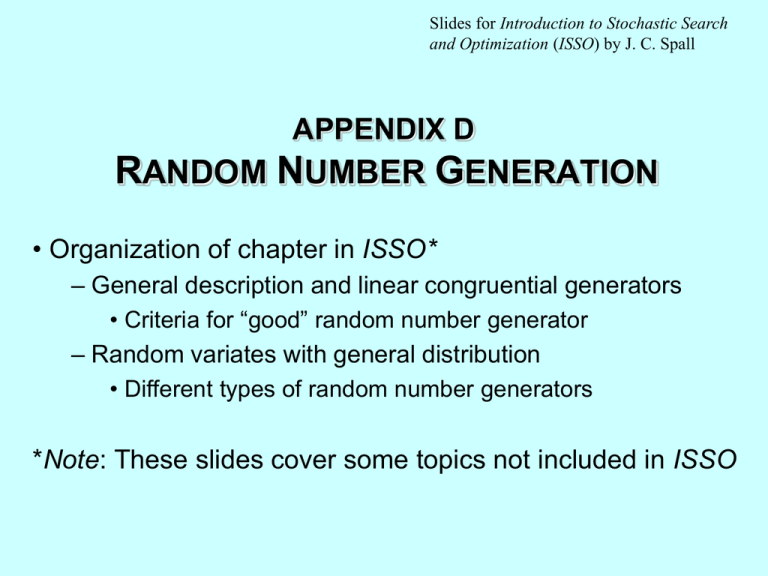
Slides for Introduction to Stochastic Search
and Optimization (ISSO) by J. C. Spall
APPENDIX D
RANDOM NUMBER GENERATION
• Organization of chapter in ISSO*
– General description and linear congruential generators
• Criteria for “good” random number generator
– Random variates with general distribution
• Different types of random number generators
*Note: These slides cover some topics not included in ISSO
Uniform Random Number Generators
• Want sequence of independent, identically distributed
uniform (U(0, 1)) random variables
– U(0, 1) random numbers of direct interest in some
applications
– More commonly, U(0, 1) numbers transformed to random
numbers having other distributions (e.g., in Monte Carlo
simulation)
• Computer-based random number generators (RNGs)
produce deterministic and periodic sequence of numbers
– Pseudo random numbers
• Want pseudo random numbers that “look” random
– Should be able to pass all relevant statistical tests for
randomness
D-2
Overall Framework for Generating
Random Numbers
• State at step k given transition function fk:
Jk fk (Jk 1, Jk 2 ,..., Jk r ), r 1
• Output function, g, produces pseudo random
numbers as
Uk g J k
• Output sequence of RNG is {Jk , k 1}
• Period of an RNG is number of iterations before
RNG output (Uk) repeats itself
D-3
Criteria for Good Random Number Generators
• Long period
• Strong theoretical foundation
• Able to pass empirical statistical tests for independence and
distribution (next slide)
• Speed/efficiency
• Portability: can be implemented easily using different
languages and computers
• Repeatability: should be able to generate same sequence
from same seed
• Be cryptographically strong to external observer: unable to
predict next value from past values
• Good distribution of points throughout domain (low
discrepancy) (also related to quasi-random sequences, not
covered here)
D-4
Criteria for Good Random Number
Generators (cont’d): Statistical Tests
• Ideal aim is that no statistical test can distinguish RNG
output from i.i.d. U(0, 1) sequence
– Not possible in practice due to limits of testing and limits of
finite-period generators
• More realistic goal is passing only key (relevant) tests
• Null hypothesis: sequence of random numbers is
realization of i.i.d. U(0, 1) stochastic process
– Almost limitless number of possible tests of this hypothesis
• Failing to reject null hypothesis improves confidence in
generator but does not guarantee random numbers will be
appropriate for all applications
• Bad RNGs fail simple tests; good RNGs fail only
complicated and/or obscure tests
D-5
Types of Random Number Generators
• Linear: commonly used
• Combined: can increase period and improve
statistical properties
• Nonlinear: structure is less regular than linear
generators but more difficult to implement and
analyze
• Physical processes (e.g., timing in atomic decay,
internal system noise, etc.)
– Not as widely used as computer-based generators due
to costliness of implementation, lack of speed, and
inability to reproduce same sequence
D-6
Linear Congruential Generators
• Linear congruential generators (LCG) produce U(0, 1)
numbers via
Jk aJk 1 c mod m
Jk
Uk ,
m
where a, c, and m are user-specified constants
• LCG appears to be most widely used and studied random
number generator
• Values a, c, and m should be carefully chosen:
0 a m, 0 c m
0 J0 m, Jk 0,1, , m 1
(LCG output may be modified to avoid 0 values for Uk)
D-7
Linear Congruential Generators
• Some famous values for a and m (assuming c = 0)
– a = 23, m = 108 + 1 (first LCG; original 1951
implementation)
– a = 65539, m = 231 – 1 (RANDU generator of 1960s; poor
because of correlated output)
– a = 16807, m = 231 – 1 (has been discussed as minimum
standard for RNGs; used in Matlab version 4)
Lehmer, D. H. (1951), “Mathematical Methods in Large-Scale
Computing Units,” Annals of the Computation Laboratory of
Harvard University, no. 26, pp. 141–146.
D-8
Example of “Minimal” Statistical Test for LCG:
Is Sample Mean Close to 0.5?
0.58
0.56
Sample Mean
0.54
m = 231 – 1, a = 4, c = 1
0.52
0.5
m = 482, a = 13, c = 14
0.48
m = 27, a = 26, c = 5
0.46
0.44
m = 9, a = 4, c = 1
0.42
0
500
1000
1500
2000
Number of Samples
D-9
Fibonacci Generators
• These are generators where current value is sum (or
difference, or XOR) of two preceding elements
• Lagged Fibonacci generators use two numbers
earlier in sequence
Jk (Jk p Jk r ) mod m
Jk
m
p, q are the lags
Uk
D-10
Multiple Recursive Generators
• Multiple recursive generators (MRGs) are defined by
Jk a1Jk 1 ak Jk r mod m
Jk
,
m
where the ai belong to {0,1,…,m – 1}
• Maximal period is m r – 1 for prime m and properly
chosen ai
Uk
• For r = 1, MRG reduces to LCG
D-11
Nonlinear Generators
• Nonlinearity sometimes used to enhance performance of
RNGs
– Nonlinearity may appear in transition function fn and/or in
output function g (see earlier slide “Overall Framework for
Generating Random Numbers”)
– Have some advantage in reducing lattice structure
(Exercise D.2) and in reducing discrepancy
• Two examples (L’Ecuyer, 1998)
– Nonlinear f = fk via quadratic recursion:
Jk (aJk21 bJk 1 c ) mod m
Uk J k M
– Nonlinear fk via inversive generator :
m 2
Jk ak c
mod m
Uk J k M
D-12
Combining Generators
• Used to increase period length and improve
statistical properties
• Shuffling: uses second generator to choose
random order for numbers produced by final
generator
• Bit mixing: combines numbers in two sequences
using some logical or arithmetic operation (addition
and subtraction are preferred)
D-13
Random Number Generators Used in
Common Software Packages
• Important to understand types of generators used in
statistical software packages and their limitations
• MATLAB:
– Versions earlier than 5: LCG with a = 75 = 16807, c = 0, m
= 231 – 1
– Versions 5 to 7.3: lagged Fibonacci generator combined
with shift register random integer generator with period
21492 (“ziggurat algorithm”)
– Versions 7.4 and later: “Mersenne twister” (sophisticated
linear algorithm with huge period 219937 )
• EXCEL: Uk = fractional part (9821Uk –1 + 0.211327);
period 223
• SAS (vers. 6): LCG with period 231 – 1
D-14
Inverse-Transform Method for Generating
Non-U(0,1) Random Numbers
• Let F(x) be distribution function of X
• Define inverse function of F by
F 1( y ) inf x : F( x) y ,0 y 1.
• Generate X by
X F 1(U )
• Example: exponential distribution
F ( x ) 1 e x
1
X F 1(U ) log(1 U )
D-15
AcceptReject Method
• Let pX(x) be density function of X
• Find function (x) that majorizes pX(x)
– Have (x) = Cq(x), C 1, q is density function that is “easy”
to generate outcomes from
• Acceptreject method generates X by following steps:
Generate U from U(0,1) (*)
Generate Y from q(y), independent of U
p (Y )
If U X
, then set X = Y. Otherwise, go back to (*)
(Y )
• Probability of acceptance (efficiency) = 1/C
• Related to Markov chain Monte Carlo (MCMC) (see
Exercise 16.4 of ISSO)
• Example to follow next two slides (pX(x) = beta density)….
D-16
60 x (1 x )
pX ( x )
0
3
2
Y ~ q( y ) U (0,1)
if 0 x 1
60Y 3 (1 Y )2
U
2.0736
otherwise
2.5
( x ) Cq( x ) 2.0736 U(0,1)
2.0
pX(x)
1.5
1.0
q(x) = U(0,1)
Note: This
example
adapted from
Law (2007,
p.438)
0.5
0
0.2
0.4
0.6
0.8
1.0
1.2
D-17
U ~ U(0,1): 0.9501, 0.2311, 0.6068, 0.4860, 0.8913,
Y ~ q(y) U(0,1): 0.7621, 0.4565, 0.0185, 0.8214, 0.4447,
p X (Y )
: 0.7249, 0.8131, 0.00018,
Cq(Y )
Accept/reject: Is U value above ratio?
X ~ pX(x): 0.7621, 0.4565, 0.0185,
reject accept reject
Accepted values represent realization of random
numbers from pX(x)
D-18
References for Further Study
• Law, A. M. (2007), Simulation Modeling and Analysis (4th ed.),
McGraw-Hill, New York, Chap. 8.
• L’Ecuyer, P. (1998), “Random Number Generation,” in
Handbook of Simulation: Principles, Methodology, Advances,
Applications, and Practice (J. Banks, ed.), Wiley, New York,
Chap. 4.
• L'Ecuyer, P. (2004), “Random Number Generation,” in
Handbook of Computational Statistics (J. E. Gentle, W. Härdle,
and Y. Mori, eds.), Springer, Chap. II.2 (pp. 3570).
• Moler, C. (2004), Numerical Computing with MATLAB (Chap.
9: Random Numbers), SIAM, Philadelphia (online at
www.mathworks.com/moler/chapters.html).
• Neiderreiter, H. (1992), Random Number Generation and
Quasi-Monte Carlo Methods, SIAM, Philadelphia.
D-19
